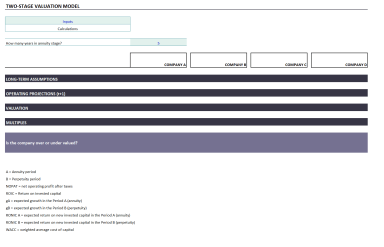
Originally published: 27/04/2023 15:09
Publication number: ELQ-98198-1
View all versions & Certificate
Publication number: ELQ-98198-1
View all versions & Certificate

Two-stage valuation model
Analysing the impact of key value drivers, such as growth, ROIC, and risk, on valuation multiples, by utilizing a two-stage valuation model
Diverse background in finance, policy-making, and international affairs, with a focus on investment banking, corporate finance, public finance, and multilateral development finance.Follow
company valuationtwo-stage valuation modelvaluation multiplesvalue driversroicenterprise valueequity value
Description
Comparing companies based on multiples is a common valuation technique used by investors to determine the relative attractiveness of investment opportunities. However, it's important to remember that multiples are simply a reflection of a company's financial performance and growth prospects. Therefore, to determine which company is more attractive, you need to look beyond the multiples and examine the key value drivers such as growth prospects, return on invested capital, and risk (cost of capital).
One approach that can be useful when analyzing multiples is the two-stage valuation model. This model breaks up the company’s value into two stages, each with different assumptions for growth and return on invested capital. The first stage uses a limited-life annuity formula to account for the company's growth during a set period of time, while the second stage uses a perpetuity formula to account for the company's long-term growth prospects.
By using a two-stage valuation model, investors can better understand how key value drivers impact a company's overall valuation (and multiples). However, it's important to note that this model is best used for companies that have reached a steady state. For companies that are, for example, expected to improve their margins due to operational efficiencies or other factors, it's best to perform an explicit forecast of those improvements and calculate the continuing value once the company reaches a steady state.
In summary, analyzing valuation multiples is not a straightforward process, and it's important to consider a range of factors beyond just these multiples. This two-stage valuation model can be a useful tool for understanding how different value drivers impact a company's valuation and multiples. Also, keep in mind that this model is about valuation mechanics, it does not help you understand what is driving ROIC, revenue growth, FCF etc. Understanding a company's historical performance, business plan, competitors, and industry trends (among other things) is essential for making informed assumptions about its key value drivers. By analyzing these factors and using valuation multiples as a tool, investors can gain a better understanding of a company's potential value and make informed investment decisions.
Comparing companies based on multiples is a common valuation technique used by investors to determine the relative attractiveness of investment opportunities. However, it's important to remember that multiples are simply a reflection of a company's financial performance and growth prospects. Therefore, to determine which company is more attractive, you need to look beyond the multiples and examine the key value drivers such as growth prospects, return on invested capital, and risk (cost of capital).
One approach that can be useful when analyzing multiples is the two-stage valuation model. This model breaks up the company’s value into two stages, each with different assumptions for growth and return on invested capital. The first stage uses a limited-life annuity formula to account for the company's growth during a set period of time, while the second stage uses a perpetuity formula to account for the company's long-term growth prospects.
By using a two-stage valuation model, investors can better understand how key value drivers impact a company's overall valuation (and multiples). However, it's important to note that this model is best used for companies that have reached a steady state. For companies that are, for example, expected to improve their margins due to operational efficiencies or other factors, it's best to perform an explicit forecast of those improvements and calculate the continuing value once the company reaches a steady state.
In summary, analyzing valuation multiples is not a straightforward process, and it's important to consider a range of factors beyond just these multiples. This two-stage valuation model can be a useful tool for understanding how different value drivers impact a company's valuation and multiples. Also, keep in mind that this model is about valuation mechanics, it does not help you understand what is driving ROIC, revenue growth, FCF etc. Understanding a company's historical performance, business plan, competitors, and industry trends (among other things) is essential for making informed assumptions about its key value drivers. By analyzing these factors and using valuation multiples as a tool, investors can gain a better understanding of a company's potential value and make informed investment decisions.
This Best Practice includes
1 excel spreadsheet




